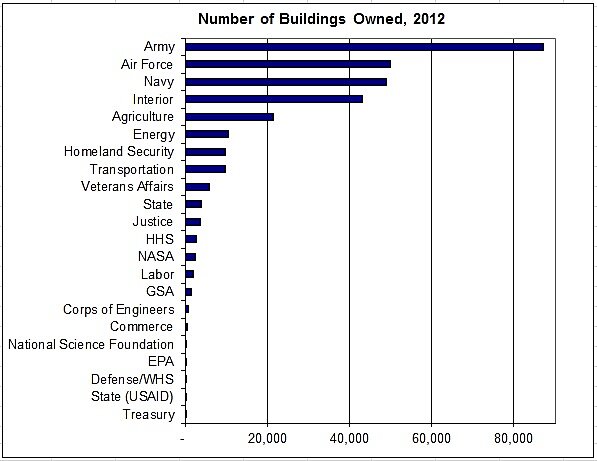How many buildings does the federal government own? 10,000? 20,000? Actually, it is a staggering 306,000, according to the U.S. General Services Administration. In addition, the government leases 55,000 buildings, for a total of 361,000. These include offices, hospitals, warehouses, and other sorts of facilities. The chart shows federal buildings owned by department.
In addition to all the buildings, the federal government owns and leases a remarkable 486,000 structures such as parking lots. The GSA reports that the annual operating costs for all the buildings and structures is $33 billion. The current market value of the buildings is unknown, but the government estimated that the replacement value in 2007 was $1.5 trillion.
A good way to save taxpayer money and increase economic efficiency would be to start privatizing these assets. The government itself says that it has about 77,000 buildings that are underutilized or unneeded.
It is widely recognized that the government is a poor manager of its assets. The GAO has had federal property on its “high risk” waste list for years, and it has found that “many assets are in an alarming state of deterioration.”
Privatizing buildings and assets is an area of some bipartisan agreement, and so the parties should move ahead with reforms. House Republicans issued a report on the waste in federal buildings in 2010. The Obama administration is also supportive of selling excess buildings and facilities.
Policymakers should focus on removing the legal and bureaucratic barriers to unloading federal assets. One problem is that the government does not know exactly what it owns, what condition assets are in, and what items are excess. The GAO says that the government has a “lack of accurate and useful data to support decisionmaking” on its vast property holdings. So the government needs much better inventory information.
Another problem is that the current process for disposing of assets is lengthy and convoluted. There are, for example, detailed requirements for repairs and environmental remediation of assets before sales. And there are burdensome rules requiring that surplus property be evaluated for possible use by homeless persons. The rules for the homeless—believe it or not—can add two years to the asset disposal process.
Sweeping away the red tape and privatizing buildings and structures would create many benefits. Selling assets would put them to more productive use in the private sector, which would boost economic growth. And using property more efficiently would save on energy, which would gain support from environmentalists.
Privatizing federal buildings would be also good fiscal policy. The sales proceeds would reduce the budget deficit in the short run, while the reduction of property maintenance costs would cut spending over the long run.
In sum, privatizing federal buildings and facilities would be a win all around. It would be good economics and good politics. So let’s get started.

